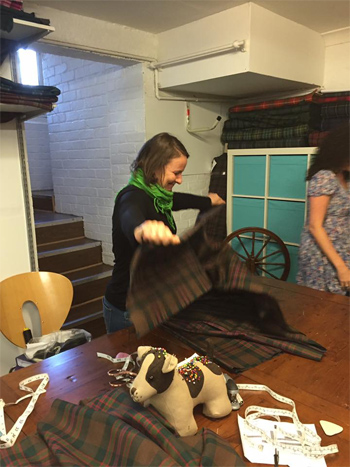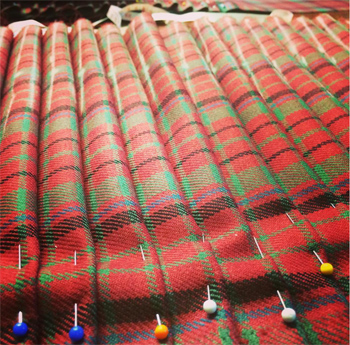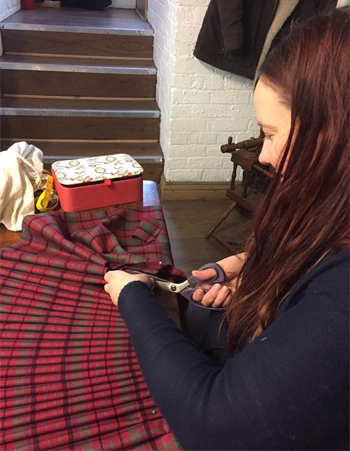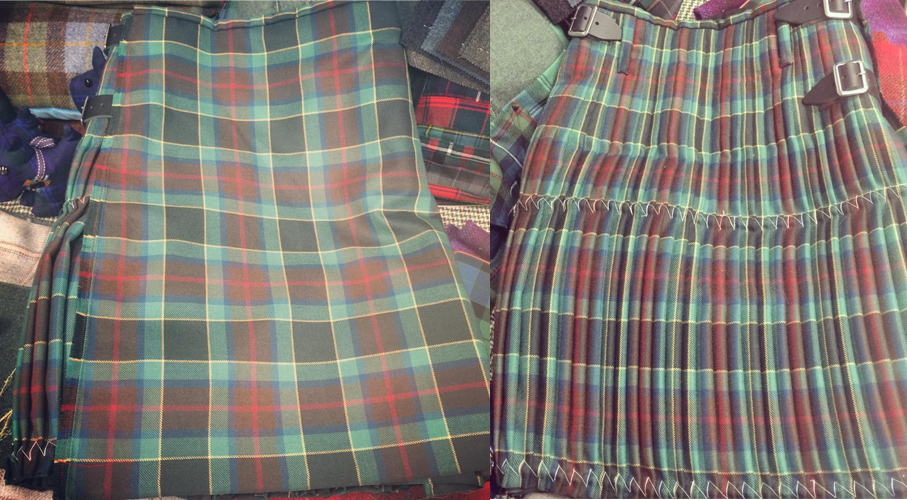When selling traditional Scottish clothing what can be more iconic than the Scottish Kilt. This has to be one of the most recognisable items of clothing in the world. Kilts are cherished for generations. As soon as you talk about kilts you hear wonderful family stories; like people still having their grandfather’s military kilt. People don’t keep other items of clothing in the same way – there is something really special and personal about a kilt.
Here at ScotClans we have been very privileged to have worked with some great kilt makers, I have always been in complete awe of their skill, it’s almost super-human. I’m a kilt lover and can sell kilts but making them is something I couldn’t imagine …. basically someone orders a kilt from us, I send the tartan out to our kilt maker living up in the Highlands. Then like magic a beautifully hand stitched kilt turns up a few weeks later. I am sure Wizard magic has been involved in the making of it.
For as long as I have been involved with the tartan industry I have known three things:
- There are very few true kilt makers out there – they are as rare as hen’s teeth.
- The art of traditional kilt making is dying out, kilt makers aren’t taking on apprentices any more.
- Making a kilt is really really hard and takes a massive amount of training – in a way it is an un-touchable craft.
Conscious that our business was growing and there will soon come a time when our kilt maker will surely reach the limit of kilts she can make for us I embarked on the quest of trying to find more kilt makers. Also I had been told that the art of traditional kilt making was probably going to die out in the next 20 years and really wanted to find new kilt makers to work with. Very soon kilts will just be machine made and imported, this is just a heartbreaking idea.
A few google searches pulled up ‘The Edinburgh Kiltmakers Academy’, this quickly turned into a visit. Both myself and Agnieszka (our very talented seamstress/crafts person) popped in to see what they were up to. In a basement below Gordon Nicholsons Kilt Makers we met Nikki Laird, basically ‘The Kilt Guru’. Together with Gordon Nicholson she had created The Edinburgh Kiltmakers Academy. It took about 10 seconds and we were both totally sold on the idea of joining the course. Thanks to CAPITB trust we were able to get funding to put both myself and Agnieszka through the kilt making course.
The Course

The course is an SVQ Level 3 in Kiltmaking. To pass you need to make 6 kilts (all by hand) including:
- A Kids Kilt pleated to stripe.
- A Gents Mediumweight 8 yard Kilt pleated to sett
- A Heavyweight Gents 8 yard Kilt
- A Kingussie Kilt
- A Ladies Kilt
- A Military Box Pleated Kilt
Oh and I think it ends in a fashion show!
We also learn about the history of kilts, highland wear and tartan.
Diary of kilt making
We are now on week 5 of the course and have completed our kids kilt and our first gents kilt. To give you an idea of the stages of making kilt:
1. Ripping the tartan
You rip the tartan to get the length of the kilt. Tartan has a selvage edge (doesn’t fray) this forms the bottom of the kilt. Ripping the tartan is fun, makes a great noise.

2. Measuring and marking out

This I imagine is going to be the hardest bit of kilt making. Understanding the tartan, how to get the most amount of pleats out of a piece of tartan. A lot of modern tartans are not designed with kilt making in mind.
Setts (the repeating pattern in tartan) can be non-matching. Basically it’s a minefield of scary things.
You start by choosing a centre point of your apron. This will match the centre point of the back of the pleats. For our kids kilt we pleated to the stripe. If you can make it out in the photo below, I picked the green stripe to pleat to.

All of the shaping on a kilt is done in the pleats. If you look at the top of the pleats, they should be tapered this is the waist to seat measurement. We were taught the art of invisible stitching for the pleats – yes proper wizard magic!
3. Cutting the pleats then steeking the pleats

Then after spending hours doing your invisible stitching you turn over the kilt and cut big chunks out of it. To stop the kilt collapsing the pleats need to be steeked (such a lovely word).
4. Internal bits

Over the cut pleats a stabilising ribbon is put in. Then the canvas is added. The waistband is added next. Then all of this inside workings is all neatly covered with a lining. Kilts are often signed by their kilt maker on the canvas. Maybe I should leave a note?

4. Finished
So thanks to ‘The Kilt Guru’ Nikki Laird I finished my kids kilt. I’m amazed it actually looks like a kilt.

Kilt number 2 – The Gents Kilt
For my Gents kilt I chose an Irish Tartan – County Waterford, after deciding on this tartan purely because I liked the colours I found out Rodger’s (the husband) grandmother was born in Country Waterford, so decided to make this kilt for my son.
This kilt was made to the sett.

What I’ve learnt
Kilt making is an incredible craft to learn – and I love it!.
The amount of work and skill that goes into a kilt is incredible and am amazed at how little kilts cost after all of this. Kilts out there are not always made by one person, most kilts you buy are made by a group of people, each just doing one part of the kilt. This isn’t good … no one is trained to fully make a kilt and bad companies out there can get away with paying kilt makers peanuts.
I am determined now to really promote that the kilts at ScotClans are and have always been made by one person and say who the kilt maker is. Kilt makers need to be paid well for their work and given the acknowledgement and respect. The Edinburgh Kiltmaking Academy has given hope that there is a future for traditional hand stitched kilts made by one person.
Additional Note
Sadly since writing this blog The Kiltmakers Academy lost it’s teacher and was unable to offer SVQs – they may be doing this in the future. Please check with the SQA website for updates.
In a twist of fate the very talented teacher from the Academy came to work for us at ScotClans – we are honoured to have her here.

Hello Amanda.
So pleased you have undertaken this Kilt Maling Course. I am sure that in time you will become an efficient, capable and industrious kilt maker producing Kilts of high quality. I know where to go in future for any further Kilt i may need(such as MachLachlan Ancient). I already have the Modern Version. May the ScotClans business go from strength to strength.
Baden J. Burnip
24 October 2016.
I would love to learn to make a kilt. Is there any place in Middle Tennessee? I would love to go to Scotland and take a course but can’t afford to stay that long
Hi Susanna,
I am in the process of learning kiltmaking from a book by Barbara Tewksbury and Elsie Stuehmeyer called The Art of Kiltmaking. Barb is also an active member of the forum xmarksthescot.com. I can message, email and Skype Barb for help whenever I need it. So far I have made one traditional full rise gents kilt, a kilt skirt for my littlest daughter, and a traditional box pleated gents kilt. You can get the book at http://www.celticdragonpress.com.
Hi! I am an American who learned how to make box pleat kilts from a fellow who was a re-enactor in French-Indian war era gatherings.
I thoroughly enjoyed the creative process. We used thicker wool fabric with true tartan when available. I never put belt/leather into the kilts. We simply made waistbands that were eventually pinned together with plain or fancy kilt pins. The prosses in which I learned was ,as I said, from a re-enactor, and we would cut the material (44″-54″ wide pieces) in half, making approximately a 22″ to 27″ length (waist to knee). Would you consider that a terrible way to create a kilt, or would that be all right under the circumstances of unofficial gatherings?